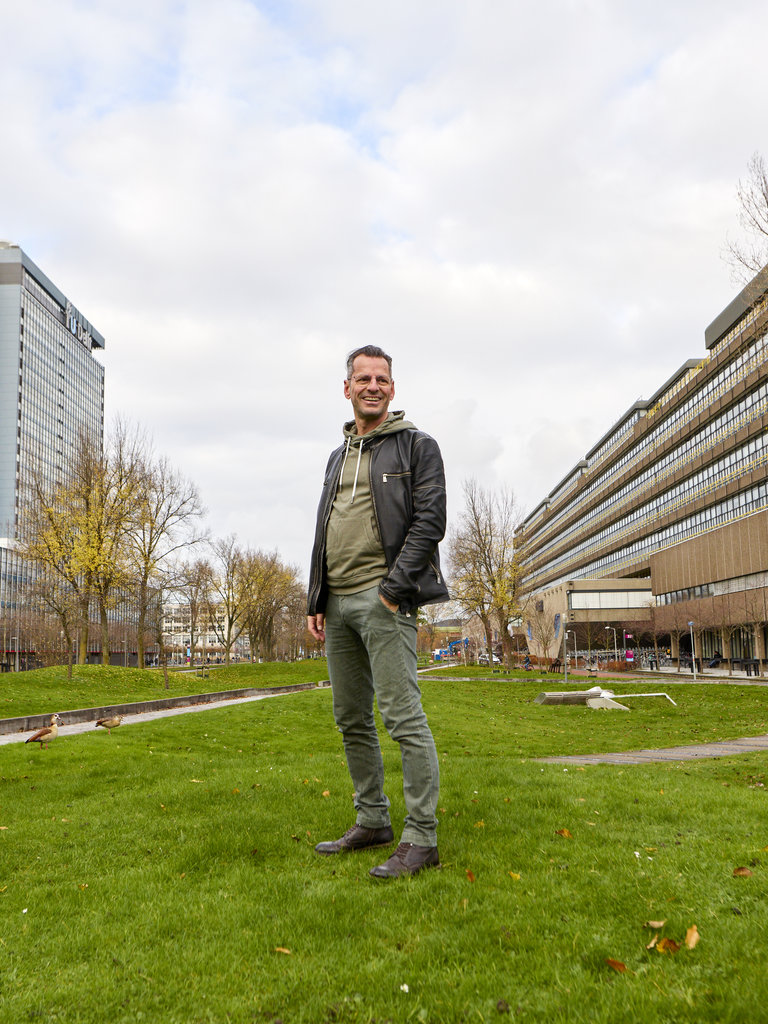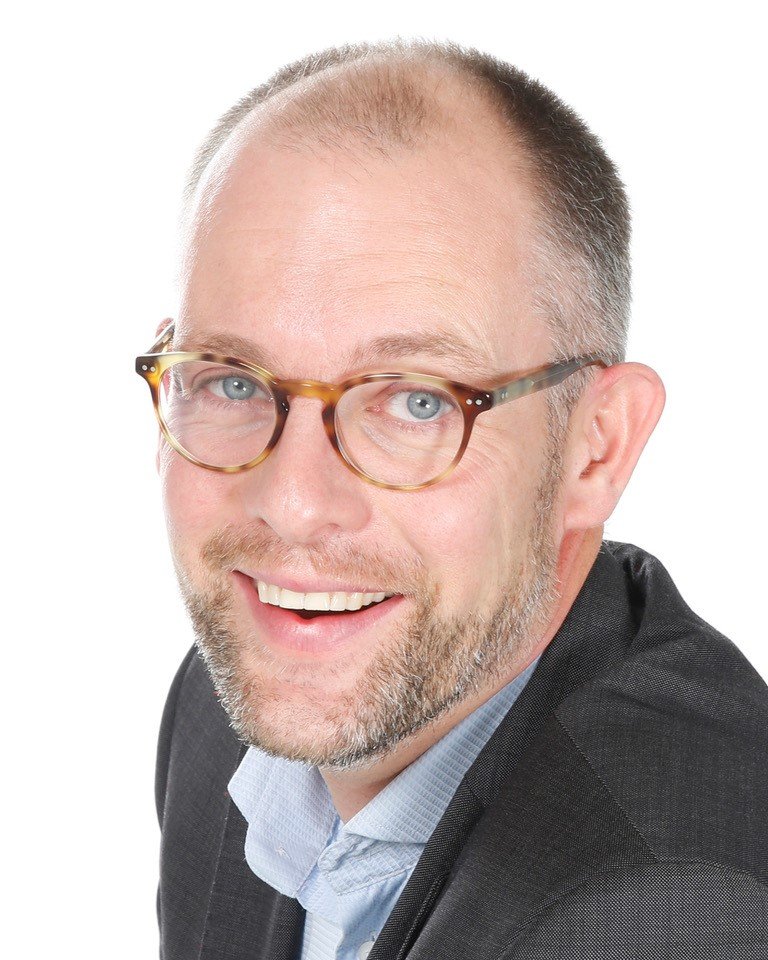
“We’re focusing on a mixture of proven and innovative techniques”
The energy transition on TU Delft Campus
By Merel Zeilstra
TU Delft has everything needed to play an important role in the energy transition with the help of technological innovations. So, what is the university itself doing to switch to renewable energy and sustainable operations? We talk to Sustainability Coordinator Andy van den Dobbelsteen and Hubert Linssen, Sustainability Programme Manager at Campus & Real Estate (CRE), about the plans for the period ahead.
Andy van den Dobbelsteen and his team have drawn up an ambitious plan to seriously reduce TU Delft’s carbon footprint and potentially even convert it into a positive climate impact. The approach is not limited to any single aspect: “If you focus on energy alone, you miss out other key areas where there is a lot to be gained. It’s also about a green campus, our food consumption and mobility.”
Renewable energy
The transition to renewable energy was set in motion years ago. Currently, wind energy from Eneco is already being used. So, that is obviously sustainable. By 2030, TU Delft aims to use energy from renewable sources only. But its ambitions go further than that. “We’ve set ourselves the target of generating half of our energy demand on campus ourselves. Because some buildings are older and in intensive use, the demand for electricity from our buildings is relatively high. We aim to achieve our targets for generation by means of solar panels and possibly also hydrogen and synthetic methane in the future,” says Van den Dobbelsteen. Besides that, the buildings that are being renovated are becoming much more energy-efficient.”
Broad scope to make an impact
Van den Dobbelsteen's interest in a sustainable transition was given a practical boost in the Faculty of Architecture and the Built Environment, when he taught the Zero-Energy Design course. As an example, he decided to analyse his own house and make it carbon neutral, and one thing led to another. “I discovered that, after saving energy at home, my impact on the climate was mainly down to food, my van and flying for work. All of the savings I’d achieved at home were completely wiped out in other areas. This is why I’m convinced that a major project such as improving the sustainability of TU Delft requires a broad scope.”
Ambitions for 2030
Some serious ambitions have been formulated with the Executive Board aimed at making the campus more sustainable. TU Delft aims to be CO2 neutral by 2030. “We’re not only taking account of energy consumption on TU Delft Campus, but also our activities, such as travel and eating,” explains Van den Dobbelsteen. Efforts are also being made to achieve complete circularity. That means recycling raw materials as much as possible and taking account of the energy performance of new materials.

Renovation pays off
In order to identify the adaptations needed to achieve the targets, an analysis of the situation in 2019 was conducted. It had some surprising results. For example, there were plans to demolish and rebuild several buildings on campus. “We were able to demonstrate that new development was actually less favourable in terms of the carbon footprint than initially thought.” It turned out that there was more to be gained from renovating old buildings and insulating them more effectively, for example. “In the case of new buildings, there’s also the production and transport of materials to consider. Then there’s the construction process. You always have to look at the whole picture,” observes Van den Dobbelsteen.
All of the things on campus came as the second surprise. “Think of all the office items, furniture and equipment – all those things have a major impact on our footprint. If we draw up a more efficient inventory of everything we have before making a purchase, that can make a big difference. We’re also focusing on circular procurement and on suppliers who work with biobased materials or who take items back after use”, says Van den Dobbelsteen.
From dream to reality
A sustainable campus with a focus on the energy supply, buildings and green areas on and around the campus sounds attractive. Campus Real Estate & Facility Management (CRE&FM) is currently hard at work making that vision a reality. Hubert Linssen, sustainability programme manager, is looking forward to the period ahead. He has a lot of experience of sustainable projects. “In 2015, I was responsible for the realisation of The Green Village and now it's there.”
CRE&FM has adopted a project-based approach to plan the renovations as the TU Delft Campus is redeveloped over the next ten years. “That means that there are plans for several major mid-life renovations and for the southern section of TU Delft Campus, our focus is on new development. At the same time, a significant expansion of solar panels is taking place. A number of buildings have already been provided and plans are ready to considerably grow solar panels on roofs and facades in the coming years”, says Linssen.
New development
New development presents a perfect opportunity to opt for a circular approach. “We’re making sure that any new buildings can be dismantled and are made from sustainable materials”, says Linssen. A building passport makes it possible to identify at a later stage what materials were used in construction in order to make reuse possible. Climate-adaptive construction, about which a great deal of experience has been gained on The Green Village, is also an area of focus for new designs. This means that the built environment needs to be capable of withstanding changing weather conditions. These include extreme rainfall and heat waves. In the years ahead, several new development projects will be built in which circularity and the changing climate have been specifically taken into account in the design. The new QuTech building will be built on the southern section of the campus and the Faculty of Applied Physics is scheduled as well.
Geothermal energy
One of the more major changes expected in the years ahead is the shift towards geothermal energy as a source for the heating grid on campus. “Geothermal energy has the potential to make a real difference for our plans. With geothermal energy, a project we are working on with partners, CO2 emissions caused by the generation of heat will be reduced to zero almost at a stroke”, explains Van den Dobbelsteen. If everything goes to plan, the installation of the heat source can start next year. Geothermal energy will not only help improve sustainability; the source on TU Delft Campus will also become one of the world’s biggest hotspots for research into geothermal energy. “The experience we gain in making this shift will be crucial for scientific research and also help innovations to advance further in this area”, says Linssen who is TU Delft's coordinator for the geothermal energy project.
As a result of the renovation work planned for the buildings, the demand for heat on TU Delft Campus is expected to fall. This means that not all heat generated will be needed immediately, which is why heat storage also has an important role to play in this project. The idea for using geothermal energy goes beyond the campus itself. “The geothermal source can supply sustainable heat to housing associations in city of Delft”, explains Linssen. Delft is located at the centre of the Rotterdam/The Hague metropolitan area, one of Europe’s most densely populated regions. “Contributing to the delivery of the sustainable heating supply for this entire area is a great ambition”, adds Van den Dobbelsteen.
We’re making sure that any new buildings can be dismantled and are made from sustainable materials
Hubert Linssen

Big laboratory with no roof
In addition to the need to minimise the negative climate impact, there are also other reasons for working on the transition towards a sustainable campus. “TU Delft aims to make an impact for a better society and we are achieving that thanks to our innovations that help the world to advance. By applying innovations in practice, we can help to remove bottlenecks. That’s why it makes total sense for our transition not only to focus on proven technology, but also to allow room to give innovative technologies a chance”, says Van den Dobbelsteen. “We need to make full use of all the knowledge collected here and facilitate that, with safe conditions, we can test to our hearts’ content. TU Delft Campus as one big, living laboratory with no roof”, concludes Linssen.
TU Delft sustainable targets
TU Delft will be:
Carbon neutral, by 2030
Referring to all TU Delft related activities done on and from the campus
Circular, by 2030
Related to all resource and waste flows going through the campus
Climate-adaptive, by 2030
Dealing with heat, drought, excessive rainfall, floods and extreme weather
Contributing to quality of life, increasingly so
Aiming at biodiversity, safety, health, comfort, inclusiveness and happiness
Exposing its excellence and sustainable character on campus
Accommodating and demonstrating living labs and innovative projects
Geothermal energy
Geothermal energy is heat from deep strata underground. Deep in the subsoil warm (salt) water is stored in various places in the Netherlands. The deeper underground, the hotter the water becomes.
Via a well in Delft, at a depth of around 2.2 km, it is possible to pump up water with a temperature of around 75 degrees. Heat exchangers transfer the heat from the groundwater to an enclosed system of pipes (heating grid), which has fresh water in it. This can be used to heat the buildings. The groundwater cools down to around 50° and is returned via a second well to the same layer of earth, underground at a distance of 1.5 km from the other well.
TU Delft, Hydreco Geomec, Energie Beheer Nederland (EBN) and Shell are collaborating on the geothermal energy project on TU Delft Campus. The intention is to realise the source on Rotterdamseweg, next to the combined heat and power plant opposite the Nieuwe Haven. The project is being run in consultation with Dutch State Supervision of Mines (SodM).
Dr Phil Vardon (Faculty of Civil Engineering and Geosciences) is coordinating the geothermal energy research programme for TU Delft. In his role as TU Delft project manager for sustainable real estate and energy systems, ir. Hubert Linssen is responsible for coordinating the project on behalf of all stakeholders.
More information: geothermiedelft.nl/en/